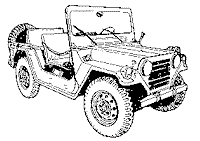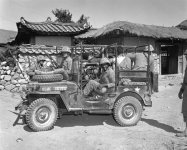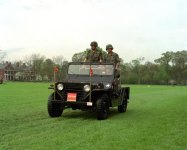The Marine Corp's M151 Fast Attack Vehicle are a variation of the old Willys-style jeep. This light-weight, all-terrain vehicle capable of high-speed, cross-country travel with high maneuverability and agility. The vehicle serves as a weapons or communications platform and carrier for anti-armor, reconnaissance, and other missions that require speed, agility, and all-terrain capability.
FAVs are refitted to mount weapons systems ranging from the M-2 .50 caliber machine gun or the M-240G machine gun to the tube launched, optically-tracked, wire-guided [TOW] antitank missile. The TOW 2 guided missile system can be either tripod mounted or mounted on a pedestal in an M151 truck.
FAVs are part of the Marine ground combat element's helicopter assault company, with the TOW variants being manned by weapons company Marines. The FAV is smaller, faster and lighter than the HMMWV, and it is not possible to load a HMMWV on a helicopter and insert it with a small unit. It can be deployed to the battlefield by loading it and the Marines that man it in a CH-53E Super Stallion. The 26th Marine Expeditionary Unit (Special Operations Capable) combined heavy firepower and quick-strike capabilities with helicopter-inserted, light infantry forces during the early 1997 Operation Silver Wake noncombatant evacuation operation (NEO) in Tirana, Albania. In 1980 the Army's 9th Infantry Division was selected as the test unit for the new High Technology Light Division (HTLD). The HTLD was designed to fight in the deserts of Southwest Asia. Critical pieces of equipment needed to realize the division concept were never available. The FAVs it wanted were neither authorized nor funded by Congress. One problem was that surrogate equipment became standard during its interim phase. For example, the FAV was replaced by the High Mobility Multipurpose Wheeled Vehicle (HMMWV).An Army health hazard assessment revealed whole-body vibration as a significant health hazard. Vehicle crew members also suffered kidney and back injuries attributable to shock and vibration sustained during testing. The health hazard assessment report recommended redesigning the seats to include the addition of more padding to reduce both vibration and shock, redesigning the vehicle suspension system to increase its shock absorbency, and entering FAV operators into a medical surveillance program tailored to the identification of whole-body vibration health effects.
Jeeps are built for off road use and could be unsafe at high speed. The rear suspension system on M151 vehicles was designed for rough terrain usage by stabilizing the stock. Military personnel operating the M151 are given special training in use of the vehicle. On paved roads, where the general public would normally use a vehicle, these vehicles are readily subject to rollover accidents. The Administrator, National Highway Traffic Safety Administration, U.S. DoT, identified the M151 vehicles as a hazard to the safety of public highway users. Therefore, for public safety, DOD renders them inoperable prior to sale (i.e., cut or crush the unitized body and suspension system). The M-151ís tendency to tip over as well as the fact that it used flammable unleaded fuel, made it a safety liability. The M-151 didnít quite have the mobility, speed, or durability to get Marines into the environments they will need to be in during the 21st century.
|
||||||||||||||||||||||||||||||
|






